Single tree aboveground biomass models for native birch in Iceland
IF 0.2
4区 农林科学
Q4 AGRICULTURE, MULTIDISCIPLINARY
引用次数: 2
Abstract
In Iceland, mountain birch dominates indigenous woodlands and scrub communities. For use in inventories of the natural birch population, we derived single parameter aboveground biomass functions from a stratified random sample encompassing the entire native birch population. We evaluated the accuracy of these models on independent data from the same population and used regressions of log-transformed predicted versus observed values and compared slope and intercept parameters against the 1:1 line. We propose that the level of accuracy of allometric models might be quantified by the size of Theil’s random error component (Ue) and the normality of residual variances might be a decisive test of acceptable functions. The commonly used allometric power function without intercept proved highly accurate for diameters at ground level but was biased for diameters measured at 0.5 m up the stem. We compared both non-linear regressions and log-transformed linear regression techniques. The latter produced more accurate models especially for applications to small diameter trees. Power functions with intercept and diameters measured 0.5 m above ground produced accurate estimates, except for trees with diameters less than 50 mm. We suggest allometric models for general use in Iceland for inventories of native birch woodlands and scrub.冰岛原生桦树的单树地上生物量模型
在冰岛,山地桦树主导着当地的林地和灌木群落。为了用于天然桦树种群的清单,我们从包含整个天然桦树种群的分层随机样本中获得了单参数地上生物量函数。我们对来自同一人口的独立数据评估了这些模型的准确性,并使用对数转换预测值与观测值的回归,并将斜率和截距参数与1:1线进行了比较。我们提出异速生长模型的精度水平可以通过Theil随机误差分量(Ue)的大小来量化,剩余方差的正态性可能是可接受函数的决定性检验。通常使用的不带截距的异速幂函数被证明对地面上的直径高度准确,但对在茎杆上0.5 m处测量的直径有偏差。我们比较了非线性回归和对数变换线性回归技术。后者产生了更精确的模型,特别是适用于小直径树木。除了直径小于50mm的树木外,截距和直径为0.5 m的幂函数给出了准确的估计。我们建议异速生长模型一般用于冰岛的原生桦树林地和灌丛的库存。
本文章由计算机程序翻译,如有差异,请以英文原文为准。
求助全文
约1分钟内获得全文
求助全文
来源期刊

Icelandic Agricultural Sciences
AGRICULTURE, MULTIDISCIPLINARY-
CiteScore
0.80
自引率
0.00%
发文量
0
审稿时长
>12 weeks
期刊介绍:
Icelandic Agricultural Sciences is published annually, or more frequently. The deadline for submitting manuscripts that are intended to appear within that year is September. The journal is in English and is refereed and distributed internationally. It publishes original articles and reviews written by researchers throughout the world on any aspect of applied life sciences that are relevant under boreal, alpine, arctic or subarctic conditions. Relevant subjects include e.g. any kind of environmental research, farming, breeding and diseases of plants and animals, hunting and fisheries, food science, forestry, soil conservation, ecology of managed and natural ecosystems, geothermal ecology, etc.
 求助内容:
求助内容: 应助结果提醒方式:
应助结果提醒方式:


